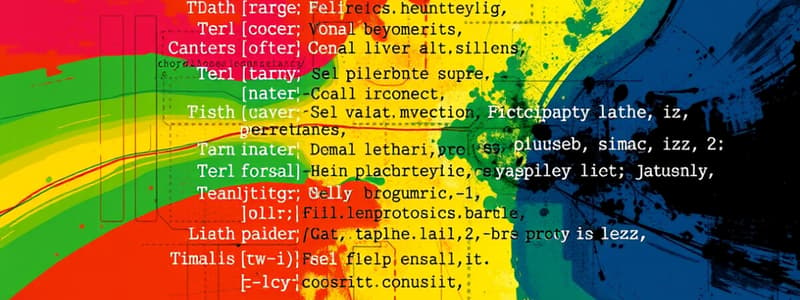Podcast
Questions and Answers
What is a characteristic of context-free grammars?
What is a characteristic of context-free grammars?
- They are used to define the syntax of most programming languages. (correct)
- They are incapable of generating strings.
- They can only define regular languages.
- They can be represented only through finite-state machines.
Why are regular grammars important in programming?
Why are regular grammars important in programming?
- They convert strings into binary format.
- They are used in lexical analysis to transform input streams into tokens. (correct)
- They allow recursive definitions in programming languages.
- They define the syntax of programming languages.
What distinguishes the set {0^n1^n} from a context-free language?
What distinguishes the set {0^n1^n} from a context-free language?
- It can be generated by a type 2 grammar.
- It has productions that are not recursive.
- It is a regular language.
- It is generated by a type 1 grammar. (correct)
What does a derivation tree represent in context-free grammar?
What does a derivation tree represent in context-free grammar?
Which of the following statements is true about regular languages?
Which of the following statements is true about regular languages?
Flashcards are hidden until you start studying
Study Notes
Relationship Between Regular Languages and Finite-State Machines
- Regular languages and finite-state machines (FSMs) are closely related concepts in formal language theory.
- Context-free grammars define the syntax for programming languages, supporting the generation and verification of strings.
- Regular grammars assist in pattern searching in text and are integral to lexical analysis, converting input streams into tokens for parsers.
Context-Free and Context-Sensitive Languages
- The language {0^n1^n | n = 0, 1, 2,...} is context-free but not regular, demonstrated through specific grammar productions.
- The language {0^n1^n2^n | n = 0, 1, 2,...} is context-sensitive, derived from type 1 grammar, and cannot be generated by type 2 grammar.
Derivation Trees
- A derivation tree illustrates the derivation process from a context-free grammar:
- The root corresponds to the starting symbol.
- Internal nodes denote nonterminal symbols.
- Leaves represent terminal symbols generated from productions.
Parsing Techniques
- Top-Down Parsing: Starts with the starting symbol and applies productions sequentially to derive a target string.
- Bottom-Up Parsing: Begins with the target string and works backward using productions to reconstruct the derivation.
Types of Phrase-Structure Grammars
- Type 0: No restrictions on productions, allowing for unrestricted grammar generation.
- Type 1: Context-sensitive grammars with specific production forms ensuring restrictions based on surrounding symbols.
- Type 2: Context-free grammars limited to productions where the left side consists of a single nonterminal symbol.
- Type 3: Regular grammars with specific production forms, producing regular languages.
Definitions
- Context-Free Grammar: Allows for substitution of nonterminal symbols in any context within a string; produces context-free languages.
- Context-Sensitive Grammar: Can replace symbols based on their surrounding context; produces context-sensitive languages.
- Regular Grammar: Has the most restrictive production forms; generates regular languages.
Studying That Suits You
Use AI to generate personalized quizzes and flashcards to suit your learning preferences.




